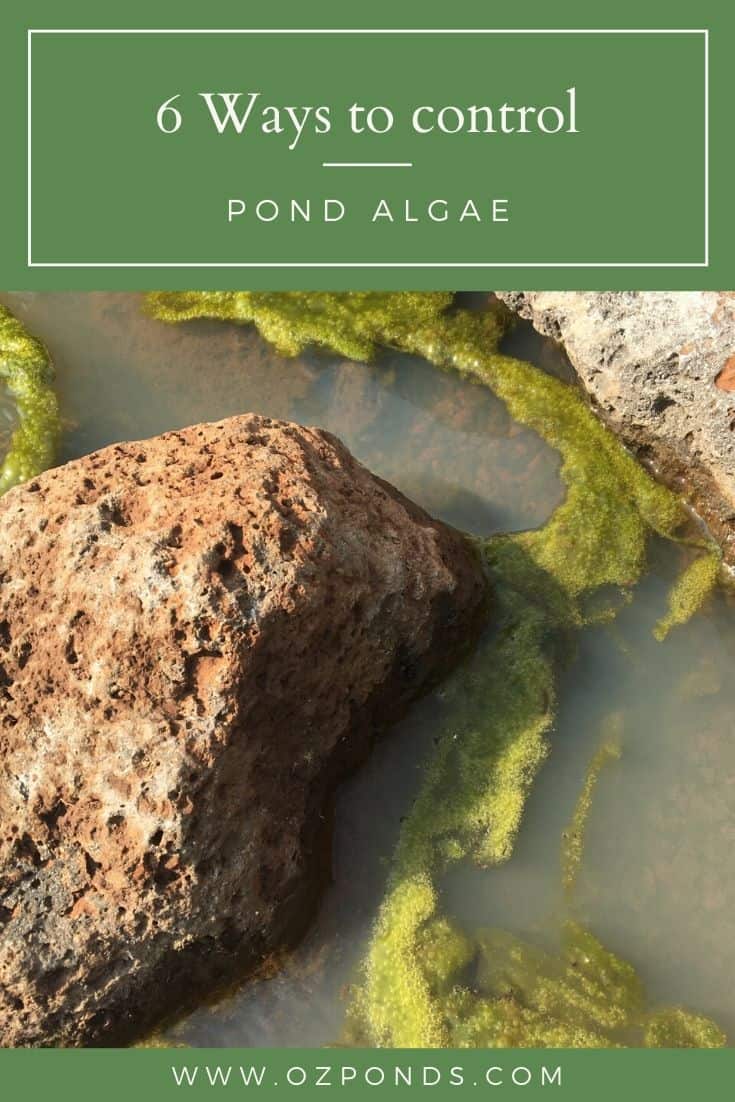Algae in ponds can be incredibly annoying. Its growth is pointing to an imbalance in the water. These are 6 methods for algae control. Which one or ones you choose to implement will depend on your individual situation.
- Algaecides- these will kill algae but the underlying issues causing the bloom will remain. You’ll need to continually reapply the algae use to keep you problems at bay.
- UV lights and ion generators- these are quite effective at killing algae in backyard ponds. You’ll need circulating water for these to be effective.
- Barley straw or barley straw extract- this releases chemicals into the water which will kill the algae. Can take a while to work.
- Adding pond dye – this will make the water darker and more difficult for the algae to photosynthesise.
- Adding nitrifying bacteria’s and enzymes- these will help improve overall water health and help consume the algae.
- Natural remedies like shading the water, adding fish or invertebrates that consume algae, preventing run off from entering the pond and enhancing filtration.
Algaecides
Algaecides work in the same way in a pond that herbicides work on land. Where a herbicide targets weeds and kills them. Algaecides target algae and kill it. They are said to be safe for fish and other aquatic plants.
A friend of mine has experience with and recommends coptrol (you can buy it on ebay). The algaecide is simply diluted and mixed with water then sprayed over the surface of the pond. Within 72hrs the algae should be dying.
Because this is a chemical it’s really important to take all appropriate precautions and read the dosage instructions extra closely.
UV lights and ion generators
UV lights are great for eliminating single celled algae the kind that turns your water green. These work by blasting the algae with UV light basically obliterating it. They are easily installed and nowadays you’ll find many pond filters actually come with built in UV lights.
Ion generators or pond ionisers are use to control what is referred to as string algae. This is the type that is long and gets tangled around your hands when you try and scoop it up. Pond ionisers work by releasing small amounts of copper ions into the water.
The ions react with the algae and cause it to die. Now i don’t have any of these on my ponds. I like to keep shrimp in some of my ponds. Shrimp don’t like copper. You certainly are always warned about using copper based medicines in aquarium tanks with shrimp.
Now as i have no first hand experience if the copper ions will negatively impact on the shrimp but if you plan on keeping shrimp within the pond, it might be something to investigate in more detail.
Barley straw & barley straw extract
Barley straw and barley straw extract are often touted as great at killing algae. Its not something i have personally used as the feedback I’ve received seems to be a little hit and miss. Some say it kills algae others that it’s a preventative measure.
They way it works in theory is that as the straw breaks down it creates all kinds of chemical reactions that will kill or prevent algae blooms from taking over your pond. The extract will work quicker as part of this reaction has already taken place.
If i were to try it i would opt for the extract is small garden ponds and the actual bales in larger bodies of water. It makes for financial sense and the bales will breakdown slower providing a more long term remedy.
Its been around a really long time so it must have some effect. Its reasonably cheap so certainly worth a shot for those wanting a more organic solution instead of rushing out and buying an algaecide.
Oh i will add that in most of the research i did on barley straw indicates that it requires plenty of oxygen in the water. So any pond with a fountain, waterfall, stream or aerator should be fine.
Pond dye
Pond dye works by making the water darker. This makes it harder for the sunlight to penetrate into the pond. Algae like any other plant needs light to photosynthesise.
I do like pond dye as an option for algae control as its defiantly effective and it adds an element of mystery to the water. Most available dyes will last quite a long time, are easy to use and safe for plants, fish and wildlife that may drink from the pond.
Its another cheap option. All the above options are great for ponds just starting out. Young ponds haven’t established a balance with nature and algae outbreaks are a part of finding the balance.
To help your pond find a healthy balance longterm keep reading.
Nitrifying bacteria’s & enzymes
Bacteria’s and enzymes are naturally occurring and will colonise a pond all by themselves. That said it doesn’t hurt to be constantly adding them to bolster your population. Nitrifying bacteria are part of the integral component of the nitrogen cycle.
Every pond owner must understand the nitrogen cycle. The basic gist is that fish and decaying organic materials (think leaves that blow into the pond) release ammonia into the water. Now ammonia is very bad for your water quality. It will kill fish and feed algae!
One type of bacteria will feed on the ammonia and convert it into nitrite. Now nitrite is still harmful to fish and also feeds algae. Lastly a second type of bacteria takes the nitrite and turn it into nitrate. This is much safer for fish. Nitrates can the be removed by water changes or pond plants using it for food.
By constantly topping up the bacteria within the pond you are ensuring that these two types are always present and working to process the ammonia and nitrite. I like to use Splosht I add a little sachet every two weeks.
Over time a layer of sludge may form on the bottom of the pond. This is perfectly fine and provides a habitat for the bacteria’s to live. You can use certain enzymes and bacterias to help consume some of this sludge layer if it becomes too thick.
If you want to learn more about the nitrogen cycle read my article “quick guide to the nitrogen cycle.”
Natural remedies
Oxygen
As I mentioned the bacteria’s and enzymes are naturally occurring. A great way to encourage a healthy population within a pond is by providing ideal living conditions. These bacteria work best when in oxygenated water. Adding air stones, fountains, streams or waterfalls are great ways to add oxygen rich water into the pond.
Rocks & pebbles
Bacteria’s will colonise all surfaces within the pond. By adding rocks and pebbles to a pond you dramatically increase the surface area available to the bacteria’s. A pond that is bare liner has much less surface area.
Shade
Shade is a great way to help control algae naturally. Not only does it limit the amount of light available to the algae but it helps to keep the water cooler. Algae thrive in warm well lit waters. Adding water lilies and tall marginal plants will help. Also plant some larger trees or shrubs on the margins of the pond.
Runoff
Run off can quite often be the cause of an algae bloom. If you notice after rain your pond begins to grow algae chances are that run off is entering the pond. As the water run off moves across the land it picks up all kinds of nutrients and debris, and dumps them in your pond. This imbalance of excess nutrients and debris will almost certainly lead to an algae bloom.
Your can prevent runoff entering the pond by placing drainage around the pond. Mounding you’re a slight been to direct water around the pond. Or even leaving a small lip of pond liner to prevent runoff entering the pond.
Fish & shrimp that eat algae
There are many breeds of fish and invertebrates that will consume algae for you. I like to use native shrimp in my ponds. Keep in mind that fish will also eat them so I like to keep them in a seperate water garden and add them to the larger ponds when needed. When choosing fish to consume algae think about your local conditions and environment and choose something appropriate.
Natural filtration
Lastly and ultimately the best thing you can do for your pond to eliminate algae is adding a bog or wetland filter. Without a doubt these things are amazing and I add them to every pond I own. Basically they work by providing a haven for bacteria’s and plants. The combination together work to provide crystal clear water back into the pond. Take a look at the slow video. I added one to my small 1000litre fish pond and the results speak for theme selves.
If you would like to learn more about wetland and bog filtration read my article on “7 reasons you should add a bog filter to your pond.”
Hopefully you are now equiped with a number of weapons to fight your algae battle. You will win! If you like what you’ve read please subscribe to our mailing list.

